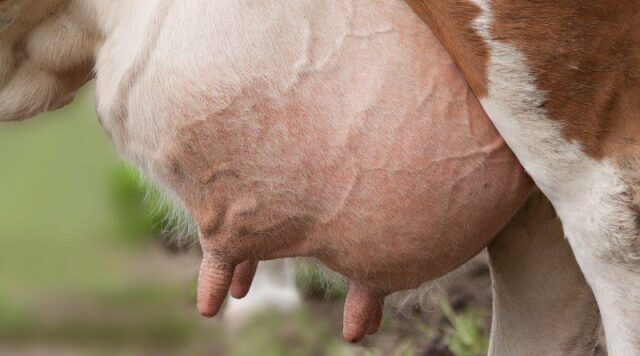
PREVENTION AND CONTROL OF MASTITIS IN DAIRY ANIMALS
Introduction
Mastitis has been observed in practically all domestic mammals and has a global geographic spread. Mastitis occurs when microorganisms enter the teat through the teat canal. Almost any bacteria can infiltrate the teat canal and induce mastitis. Climatic circumstances, seasonal change, bedding, animal population housing density, and husbandry procedures, such as dairy animal milking protocols, all have an impact on incidence and etiology of mastitis. The principal reservoirs of mastitis might be either contagious or environmental in nature. Contagious spread of pathogens occurs during milking, through milkers’ hands or milking equipment acting as fomites. For contagious pathogens, adult lactating cattle are most at risk of infection. Some pathogens are opportunistic invaders from the animal’s environment. The bedding used to house cattle is the primary source of environmental pathogens; however, contaminated teat dips, intramammary infusions, water used for udder preparation before milking, water ponds or mud holes, skin lesions, teat trauma and flies have all been incriminated as sources of infection for mastitis. Milking hygiene also decreases the new infection risk of environmental pathogens.
Based on the presence or absence of clinical signs, mastitis can often be described as subclinical or clinical mastitis. Clinical mastitis in most dairy herds is caused by environmental pathogens. In addition, many clinical mastitis cases are transient, especially those that are initial episodes for a cow and quarter. The assessment of clinical mastitis within a herd is based on incidence and not prevalence. Prevention of clinical mastitis in cattle is possible only by decreasing microbe exposure to the teats. New subclinical mastitis infections are prevented by focusing management efforts on decreasing the presence of pathogens on the teat end. Clean and dry bedding, clean and dry udders at the time of milking, and not using water during the milking protocols as well as maintaining teat-end health have a positive effect on control of mastitis.
Prevention of mastitis
The fundamental principle of mastitis control is controlling the disease by either decreasing the exposure of the teat to potential pathogens or by increasing resistance of dairy animals to infection. To produce high quality milk and sustain udder health in dairy farming, a comprehensive strategy to control and prevention of mastitis is required. This can be achieved by adopting the following practices.
- Treatment of clinical cases of mastitis
Clinical mastitis is classified as peracute, acute, subacute or chronic based on the severity and duration of occurrence of symptoms. Mastitis should be treated based on herd data and personal experience, with a focus on eradicating the causing bacteria when possible. The mastitis case must be treated immediately at 12 or 24 hour intervals, depending on the etiology and severity of the case. In general, it is recommended to utilize narrow-spectrum antibiotics. Teat ends should be completely cleansed with 70% alcohol before delivering intramammary medicines in clinical cases. A persistently ill animal that is not responding to treatment should be culled or segregated. It is a highly effective means of eradicating existing infection and preventing transmission to other animals. However, using antimicrobials to treat subclinical mastitis during lactation can be costly and ineffective.
- Teat-dipping
Teat dipping is a process that involves applying a germicidal solution to the teats of lactating animals after milking. Postmilking teat dipping reduces bacteria on teat and prevents new intramammary infections between milking. Teat dips can be of two distinct classes. 1. Non-barrier type teat dips and 2. Barrier type teat dips. Non-barrier teat dips have traditionally focused on the use of fast acting antimicrobial compositions for both premilking and postmilking operations. Barrier type teat dips, used mostly in the postmilking operation, typically also comprise an antimicrobial agent, but are applied for longer term contact and form a coating or a film protecting the teat skin from microbes that otherwise would have access and infect the skin.
A number of different types of disinfectants are used in teat dips, including iodine with iodophors, chlorhexidine, acidified sodium chlorite, organic acids, peroxides, quaternary ammonium chlorides and others. Another group of active compounds that are gaining favor are organic acids. These include lactic acid, dodecylbenzene sulfonic (DDBSA), caprylic, salicylic, glycolic and capric acids. These products should be applied as a dip, rather than as spray immediately after milking.
- Dry Cow Therapy
Dry cow therapy (DCT) has become an essential component of the mastitis control plan in dairy bovines. Cows are naturally protected against intramammary infections during the dry period by formation of a keratin plug in the teat canal. However, time of teat canal closure varies among cows. Teats which do not form a plug-like keratin seal are thought to be most susceptible to infection. DCT is carried out at the end of lactation. In this, dairy cows are treated with antibiotics to prevent and treat mastitis during the dry period.
Two types of DCT are followed. 1. Blanket dry cow treatment (BDCT): In this, all the cows are treated with antibiotics during the dry period.2. Selective dry cow therapy (SDCT): In this, only infected cows or quarters are treated. Uninfected quarters/cows are not administered with intramammary antibiotics. These are to be used under the supervision of a veterinarian. Treatment with the help of intramammary antibiotics resolves mastitis and averts new infections from recurring over the dry phase. Usage of alcohol wipes before attaching dry cow tubes is a hygienic practice that prevents the spread of bacteria and other forms of contamination. Selective Dry Cow Therapy is becoming more popular as it may reduce antibiotic resistance when compared to BDCT.
- Nutrition
A balanced diet plays an important role in udder resistance to infection because certain nutrients affect various mammary resistance mechanisms. Correctly compiled and mixed feed ration which meets all the requirements during the individual stages of lactation (phase nutrition) can achieve increased resistance of dairy cows to mastitis causing pathogens. When composing and mixing the feed ration, it is necessary to use feeds that are safe from fungi and mycotoxins. A feed ration with the necessary amounts of vitamins, minerals and other immunostimulatory additives improves the body’s defenses against pathogenic bacteria and subsequent risk of causing mastitis. Vitamin E and selenium compounds are among the most effective antioxidant nutrients. Humic acids have been added to feed ration in recent years to increase the body’s defenses and eliminate adverse conditions that could lead to the occurrence of various metabolic diseases and ailments. They are based on lignin collectively with other components of plant biomass. The supplementation of humates to the feed, stimulates the immune system and the growth of symbiotic rumen microflora also.
- Herd Environment and Management practices
Dairy farm management methods are critical in preventing and controlling mastitis. Improving udder health and getting rid of mastitis depends on the cleanliness of the area where the animals are kept. It is advised to replace the bedding material (straw, sawdust) at regular intervals and removal of dung should be frequently done. The shed must always be dry and clean to prevent the formation of a breeding ground for bacteria, which causes environmental mastitis. It is good to use lime or special commercial products available on the market to disinfect and absorb excess moisture from sheds. The floor of the shed should be non-slippery and smooth flooring is not preferred in dairy farms because of chances of injuries. The animal shed should have proper ventilation also. Mastitis exposure is minimized when all areas of the environment are clean, cool and dry. The animal should have no access to manure, mud, or pools of stagnant water and calving area must be clean. Resistance is maximized by providing a stress free environment that minimizes teat injury and by feeding balanced diets.
A proper milking hygiene program fulfilling all the biological and hygienic requirements of the dairy animal is required. Regular cleaning and disinfection of the milking parlor should be observed. It is important to separate sick dairy cows from healthy animals until they are completely cured or eliminated. Milkers must adhere to a well defined procedure involving personal hygiene measures like washing hands with soap and water, washing teats and udder in sanitizing solution, thoroughly drying teats and udder with individual towels, dipping teats in an effective germicidal teat dip, allowing 30 seconds of contact time before wiping off teat dip with an individual towel, thoroughly scrubbing the teat end with a cotton swab soaked in alcohol, first strips from all the quarters in a container with a black bottom and perform a sensory assessment of the quality of the milk, postmilking dip application, rinsing and regular technical maintenance of milking equipment, feed the cows after milking for about 20-30min to keep them upright until the teat close etc.
- Vaccination Procedures
Immunoprophylaxis of mastitis involves means and methods for targeted enhancement of specific immunity to an infectious agent. The possibility of vaccinating cows against specific pathogens causing intramammary infections is a relatively new specific tool for suppressing, controlling and preventing udder inflammation. Monovalent or polyvalent vaccines can be used in a mastitis control programs. Available vaccines can shorten the duration of infection and limit the circulation of some contagious microorganisms causing udder inflammation. However, the preventive use of the vaccine in production herds is an economic burden associated with higher costs of purchase and administration.
Conclusions
The effective prevention programs against mastitis must include clean and dry housing of animals, correctly chosen milking procedure, initiation of early and adequate treatment of clinical cases of mastitis, effective management and selective use of antibiotics in the drying off cows, strict adherence to the hygienic protocol for milking etc. These measures can create a complete approach for controlling the most critical activities that are directly related to the initiation and spread of mastitis in the herd. Current scientific information and the daily implementation of established prevention and control measures in the dairy farms, can significantly affect the overall production, quality and nutritional value of milk with a favorable impact on consumer health

Jinu Manoj* and Manoj Kumar Singh
*DIO, College Central Laboratory, LUVAS, Hisar, Haryana
Assistant Professor, COVAS, SVPUAT, Meerut, Uttar Pradesh



















